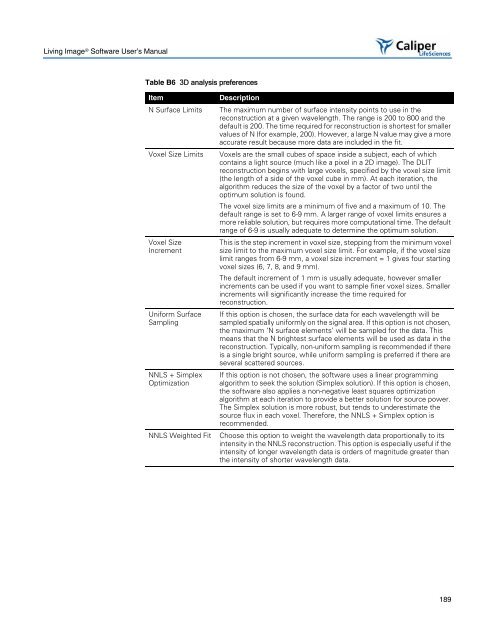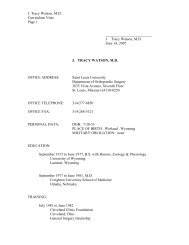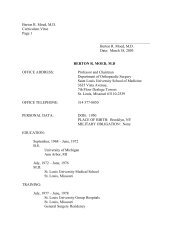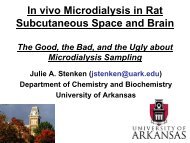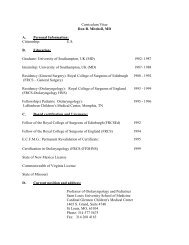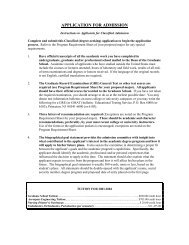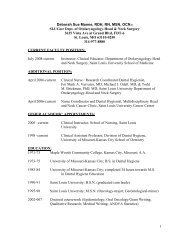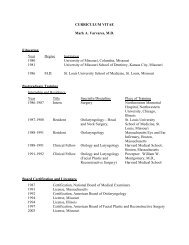Living Image 3.1
Living Image 3.1
Living Image 3.1
You also want an ePaper? Increase the reach of your titles
YUMPU automatically turns print PDFs into web optimized ePapers that Google loves.
<strong>Living</strong> <strong>Image</strong> ® Software User’s Manual<br />
Table B6 3D analysis preferences<br />
Item Description<br />
N Surface Limits The maximum number of surface intensity points to use in the<br />
reconstruction at a given wavelength. The range is 200 to 800 and the<br />
default is 200. The time required for reconstruction is shortest for smaller<br />
values of N (for example, 200). However, a large N value may give a more<br />
accurate result because more data are included in the fit.<br />
Voxel Size Limits Voxels are the small cubes of space inside a subject, each of which<br />
contains a light source (much like a pixel in a 2D image). The DLIT<br />
reconstruction begins with large voxels, specified by the voxel size limit<br />
(the length of a side of the voxel cube in mm). At each iteration, the<br />
algorithm reduces the size of the voxel by a factor of two until the<br />
optimum solution is found.<br />
The voxel size limits are a minimum of five and a maximum of 10. The<br />
default range is set to 6-9 mm. A larger range of voxel limits ensures a<br />
more reliable solution, but requires more computational time. The default<br />
range of 6-9 is usually adequate to determine the optimum solution.<br />
Voxel Size<br />
Increment<br />
Uniform Surface<br />
Sampling<br />
NNLS + Simplex<br />
Optimization<br />
This is the step increment in voxel size, stepping from the minimum voxel<br />
size limit to the maximum voxel size limit. For example, if the voxel size<br />
limit ranges from 6-9 mm, a voxel size increment = 1 gives four starting<br />
voxel sizes (6, 7, 8, and 9 mm).<br />
The default increment of 1 mm is usually adequate, however smaller<br />
increments can be used if you want to sample finer voxel sizes. Smaller<br />
increments will significantly increase the time required for<br />
reconstruction.<br />
If this option is chosen, the surface data for each wavelength will be<br />
sampled spatially uniformly on the signal area. If this option is not chosen,<br />
the maximum ‘N surface elements’ will be sampled for the data. This<br />
means that the N brightest surface elements will be used as data in the<br />
reconstruction. Typically, non-uniform sampling is recommended if there<br />
is a single bright source, while uniform sampling is preferred if there are<br />
several scattered sources.<br />
If this option is not chosen, the software uses a linear programming<br />
algorithm to seek the solution (Simplex solution). If this option is chosen,<br />
the software also applies a non-negative least squares optimization<br />
algorithm at each iteration to provide a better solution for source power.<br />
The Simplex solution is more robust, but tends to underestimate the<br />
source flux in each voxel. Therefore, the NNLS + Simplex option is<br />
recommended.<br />
NNLS Weighted Fit Choose this option to weight the wavelength data proportionally to its<br />
intensity in the NNLS reconstruction. This option is especially useful if the<br />
intensity of longer wavelength data is orders of magnitude greater than<br />
the intensity of shorter wavelength data.<br />
189


